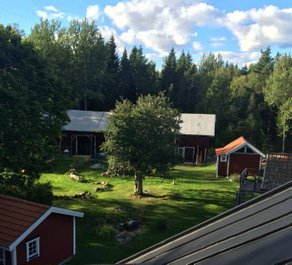The ashram, Samba Sada Shiva Dham, was founded in 1992 and is located in Roslagen approximately 120 km north of Stockholm. The Foundation Samba Sadashiva is the owner of the ashram property since 2013. The Foundation takes care of the ashram according to the message of Shri Babaji of Truth, Simplicity and Love. The aim of the Foundation is to preserve and develop the ashram to support the spiritual and human evolution and cooperation of its visitors.
The heart of the ashram is the temple and the dhuni. The temple is situated in an old barn, and the dhuni is surrounded by forest. The forest is the larger part of the ashram, and one third of it is since a few years back classified as a protected biotope by the Swedish Forest Agency. There are even some smaller buildings on the ashram property. There are plans for the further development of the ashram, including among other things renovation and the conversion of the barn for future needs. See more on the Project page.
The ashram has been visited by many guests from both locally and far further away such as India, USA and other European countries. Through the years we have had good contact with the Hindu Mandir Society and the Swedish Indians Association (SIA) in Stockholm. We also have continual contact with other Babaji Ashrams and Babaji centers around the world. Here below is a summary of some of the occurrences and things that have helped to form the Ashram to what it is today.
In 1994 the ashram was visited by Alok Bannerjee, who later became president of the Internation Haidakhan Samaj, as well as Hari Govind Baba and a group of international guests. During that visit the Dhuni, fire temple, was inaugurated in the woods.
In the Summer of 2003 the ashram was visited by Shri Mahamandaleshwar, an Indian Master who was himself the leader of many ashrams in India. Before his visit a Mandir, an Indian temple, was erected in part of the barn. Shri Mahamandaleshwar performed the first puja here during a three-day long program with around 70 visitors. A two-day program was also arranged in Stockholm in cooperation with Hindu Mandir Society whose members include many of Stockholm’s Hindus.
Thanks to the cooperation with SIA – Swedish Indians Association we became the host for a 450 kilogram heavy Shiva Linga in 2007. This Mahakaleshwara Linga filled the place in the Mandir for several months before it was permanently placed in the Hindu Burial place at Strandkyrkogården in Tyresö. We also participated in the inauguration ceremony at Strandkyrkogården in Tyresö, in the presence of the Indian ambassador and Swedish politicians. The Mahakaleshwara Linga is now used in traditional Hindu burial rites.
In 2010 we received, thanks to the same Indian contacts in Stockholm, a donation from India in the form of a Shiva Linga in white and black marble. The name of that Linga - Samba Sada Shiva Linga, expresses a union between the Divine Mother and the Holy Shiva, exactly as the name of this Ashram. The inauguration ceremony was led by Swami Nirdosha from India and Stockholm, and attended by Indian’s Ambassador Ashok Sajjanhar and more than 30 other guests.
In June 2013 the Foundation Samba Sadashiva became the legal owner of the property of the ashram. With the Foundation as owner, the prospects for the future are stable and long-lasting. The possibilities for further evolution of the ashram are many and great.
Since year 2015 one third of the ashram property is classified as protected biotope by the Swedish Forest Agency. This part of the forest contains great biological diversity since it was never clear-cut, and it houses many protected species.
The summer of 2016 a Unity Gathering was arranged with many participants, also from other countries. For three days and nights people gathered to sing aarati and kirtan, and do pujas and a yagya. There was also a guided tour of the forest, and a satsang on the theme of spiritual experiences and the message of Shri Babaji. The next year a similar gathering was arranged during the summer solstice on June 21st.
The forest
The land of the ashram consists largely of forest, that has been shown to be very varied with a large biological diversity. The forest varies between old fir and pine and older fields with deciduous and coniferous trees. In the calcareous ground several orchids grow, for example butterfly orchid, broad-leaved helleborine, twayblade and heath spotted orchid. The trust has been given the task of caring for the land so that its nature and recreational value is maintained or increased and guarantees that the land is not sold or exploited in some other way. The forest invites both relaxing walks and contemplation. For those not used to walk in the forest there is a nature path that is easy to follow.
Since 2015 one third of the forest is nominated as a protected biotope by the Swedish Forest Agency. This means it is protected by law for future generations.

